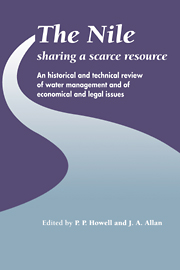 The Nile: Sharing a Scarce Resource
The Nile: Sharing a Scarce Resource Book contents
- Frontmatter
- Contents
- Preface
- List of Contributors
- Orthography
- Units and Conversion Factors
- Introduction
- I Environmental history of the Nile and its management
- 1 Origin and evolution of the Nile
- 2 History of Nile Flows
- 3 History of water use in the Sudan and Egypt
- 4 East Africa's water requirements: the Equatorial Nile Project and the Nile Waters Agreement of 1929. A brief historical review
- 5 History, hydropolitics and the Nile: Myth or reality
- II Nile management and factors affecting future management
- III Future utilisation of Nile waters
- IV Economic, international and legal issues
- Index
4 - East Africa's water requirements: the Equatorial Nile Project and the Nile Waters Agreement of 1929. A brief historical review
Published online by Cambridge University Press: 05 February 2012
- Frontmatter
- Contents
- Preface
- List of Contributors
- Orthography
- Units and Conversion Factors
- Introduction
- I Environmental history of the Nile and its management
- 1 Origin and evolution of the Nile
- 2 History of Nile Flows
- 3 History of water use in the Sudan and Egypt
- 4 East Africa's water requirements: the Equatorial Nile Project and the Nile Waters Agreement of 1929. A brief historical review
- 5 History, hydropolitics and the Nile: Myth or reality
- II Nile management and factors affecting future management
- III Future utilisation of Nile waters
- IV Economic, international and legal issues
- Index
Summary
From 1898 until the late 1940s attention on the waters of the Nile focused almost entirely on the irrigation needs of Egypt and the Sudan. The possible future requirements of Ethiopia, occupying almost the entire catchment of the Baro/Sobat, Blue Nile and Atbara and providing over 80 per cent of the average Nile flow at Aswan, were ignored, their liberty to exploit their own resources having been limited by treaty. Equally, the countries at the headwaters of the White Nile, with substantial annual rainfall, were not thought of as areas where irrigation might be needed, regardless of the unpredictability and uneven distribution of rainfall in some parts and a high level of aridity in others. From the early 1950s, however, Egypt's proposals for storage in the Great Lakes and Uganda's plans for hydro-electric power at Owen Falls set in motion studies to determine East African water resources in general and irrigation needs in particular, as well as the level of constant discharge through the turbines required to meet growing electricity demand and the planning of future power stations. Professional staff, both as advisers and as members of the Water Development Departments in each of the three East African territories, were appointed with qualifications to match those of officials in the downstream states and a number of studies and surveys was set in motion to examine the technical and economic factors involved.
- Type
- Chapter
- Information
- The Nile: Sharing a Scarce ResourceA Historical and Technical Review of Water Management and of Economical and Legal Issues, pp. 81 - 108Publisher: Cambridge University PressPrint publication year: 1994
- 5
- Cited by


